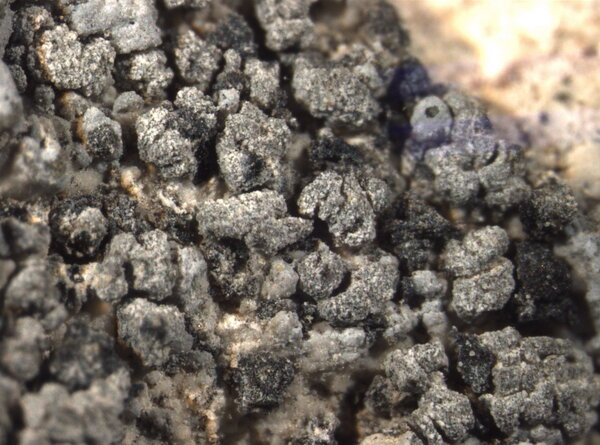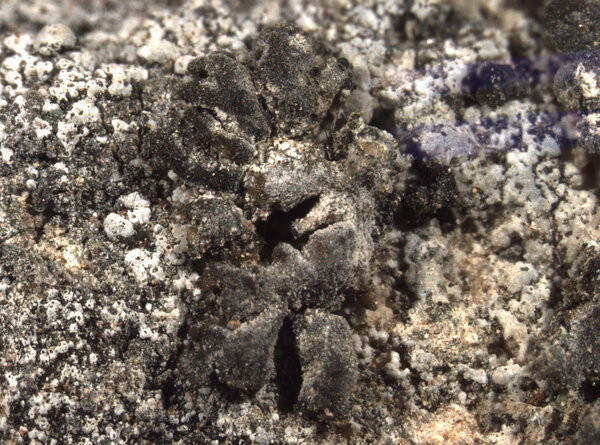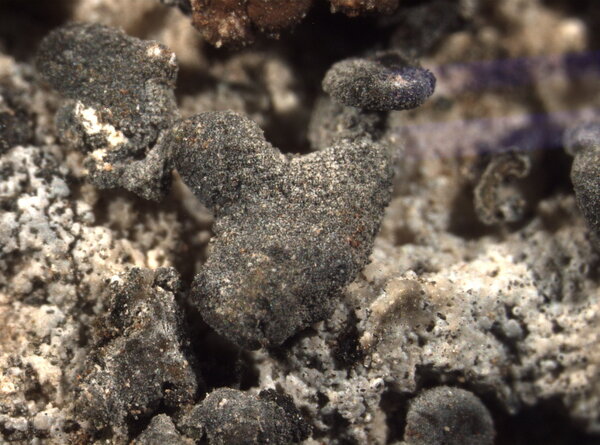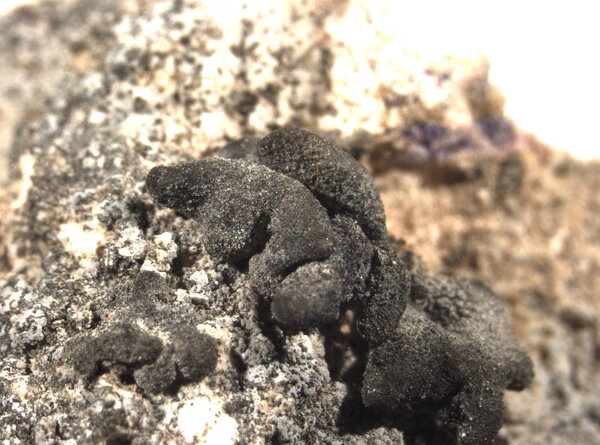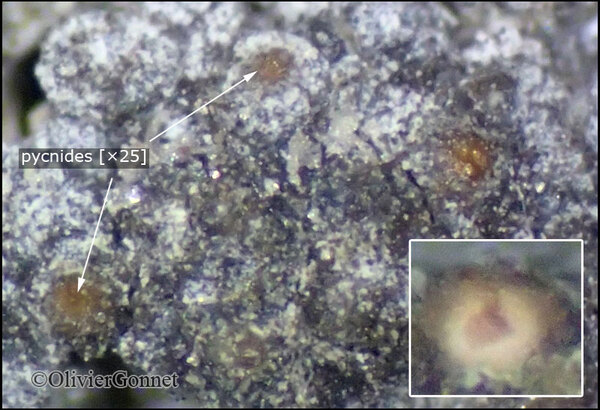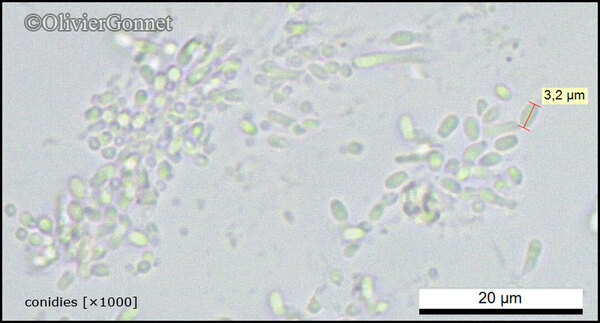Anema decipiens (A. Massal.) Forssell
N. Acta Reg. Soc. Sci. Upsal., ser. 3, 13: 92, 1885. Basionym: Omphalaria decipiens A. Massal. - Framm. Lichenogr.: 14, 1855.
Synonyms: Collema decipiens (A. Massal.) Nyl.; Thyrea decipiens (A. Massal.) A. Massal.
Description: Thallus squamulose, homoiomerous, slightly gelatinous when wet, in section with a loosely reticulate network of thin hyphae enclosing groups of cyanobacterial cells. Squamules 1-2 mm wide, brown-black to black, but usually blue-pruinose, with a mostly entire margin, dispersed to usually crowded and forming effuse crusts, with an entire to shallowly incised margin, covered in small, soredia- or isidia-like granules. Apothecia pycnoascocarps, 1-2 per squamule, at first immersed and urceolate, but soon expanded and clearly lecanorine, 0.3-0.5 mm across, with a dark reddish brown, concave to flat disc, and a thick, rugose, pruinose thalline margin. Proper exciple absent or very thin, cupular; epithecium orange-brown, thin; hymenium colourless, 100-150 µm high, the hymenial gel I+ deep blue; paraphyses in part simple, straight, long-celled, partly moniliform, 3-4 µm thick, the apical cell slightly swollen, up to 5 µm wide; hypothecium pale orange-brown, 20-50 µm high in central part. Asci 8-spored, broadly clavate, thin-walled, with a distinct amyloid outer cap, but no apical dome, Peccania-type. Ascospores 1-celled, hyaline, broadly ellipsoid to subglobose, 9-15 x 7-10 µm, the wall 1-2 µm thick. Pycnidia immersed, globose to pyriform, unilocular or later plurilocular, 70-140 µm wide. Conidia hyaline, ellipsoid to narrowly ellipsoid, 2.5-4 x 1.5-2 µm. Photobiont cyanobacterial, chroococcoid, of a few. 3-5 µm wide cells often penetrated by haustoria and surrounded by a gelatinous sheath which is colourless in inner parts, yellowish brown near the thallus surface. Spot tests: all negative. Chemistry: without lichen substances.
Growth form: Crustose
Substrata: rocks
Photobiont: cyanobacteria, coccaceous (e.g. Gloeocapsa)
Reproductive strategy: mainly sexual
On otherwise dry surfaces with short periods of water seepage after rain
Commonnes-rarity: (info)
Alpine belt: absent
Subalpine belt: absent
Montane belt: rare
Dry submediterranean belt: rather common
Humid submediterranean belt: rather rare
Padanian area: extremely rare
pH of the substrata:
1 2 3 4 5
Solar irradiation:
1 2 3 4 5
Aridity:
1 2 3 4 5
Eutrophication:
1 2 3 4 5
Poleotolerance:
0 1 2 3
Altitudinal distribution:
1 2 3 4 5 6
Rarity
absent
extremely rare
very rare
rare
rather rare
rather common
common
very common
extremely common
Loading data...
Occurrence data
Predictive map
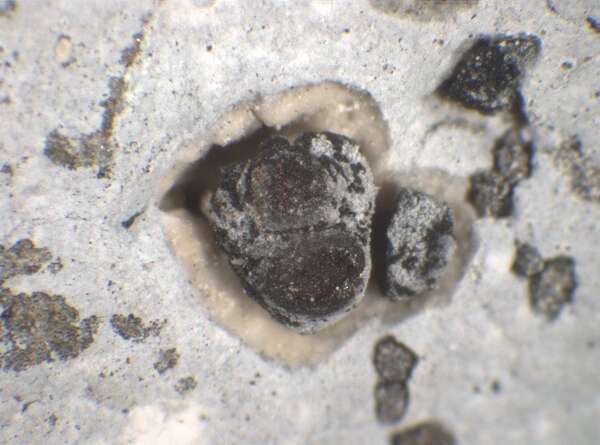
P.L. Nimis; Owner: Department of Life Sciences, University of Trieste
Herbarium: TSB (33890)
2003/03/11
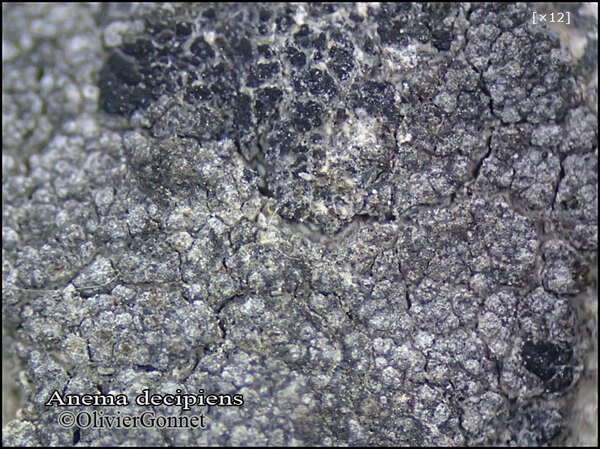
courtesy Olivier & Danièle Gonnet - Source: https://www.afl-lichenologie.fr/Photos_AFL/Photos_AFL_A/Textes_A3/Anema_decipiens.htm
France, Fort de l'Écluse, alt. 610 m - Léaz- Ain
9/10/2018
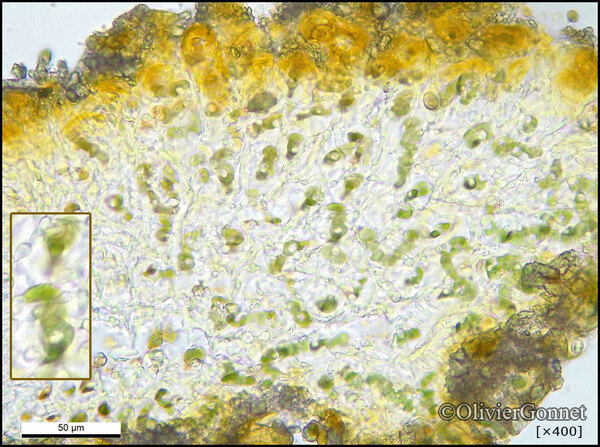
courtesy Olivier & Danièle Gonnet - Source: https://www.afl-lichenologie.fr/Photos_AFL/Photos_AFL_A/Textes_A3/Anema_decipiens.htm
France, Fort de l'Écluse, alt. 610 m - Léaz- Ain
9/10/2018
Growth form: Crustose
Substrata: rocks
Photobiont: cyanobacteria, coccaceous (e.g. Gloeocapsa)
Reproductive strategy: mainly sexual
On otherwise dry surfaces with short periods of water seepage after rain
Commonnes-rarity: (info)
Alpine belt: absent
Subalpine belt: absent
Montane belt: rare
Dry submediterranean belt: rather common
Humid submediterranean belt: rather rare
Padanian area: extremely rare
pH of the substrata:
| 1 | 2 | 3 | 4 | 5 |
Solar irradiation:
| 1 | 2 | 3 | 4 | 5 |
Aridity:
| 1 | 2 | 3 | 4 | 5 |
Eutrophication:
| 1 | 2 | 3 | 4 | 5 |
Poleotolerance:
| 0 | 1 | 2 | 3 |
Altitudinal distribution:
| 1 | 2 | 3 | 4 | 5 | 6 |
Rarity
absent
extremely rare
very rare
rare
rather rare
rather common
common
very common
extremely common
Loading data...
Occurrence data
Predictive map

P.L. Nimis; Owner: Department of Life Sciences, University of Trieste
Herbarium: TSB (33890)
2003/03/11

courtesy Olivier & Danièle Gonnet - Source: https://www.afl-lichenologie.fr/Photos_AFL/Photos_AFL_A/Textes_A3/Anema_decipiens.htm
France, Fort de l'Écluse, alt. 610 m - Léaz- Ain
9/10/2018



